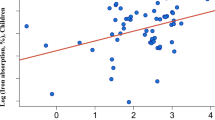Abstract
Milk thistle contains silybin, which is a potential iron chelator. We aimed to determine whether silybin reduced iron absorption in patients with hereditary haemochromatosis. In this crossover study, on three separate occasions, 10 patients who were homozygous for the C282Y mutation in the HFE gene (and fully treated) consumed a vegetarian meal containing 13.9 mg iron with: 200 ml water; 200 ml water and 140 mg silybin (Legalon Forte); or 200 ml tea. Blood was drawn once before, then 0.5, 1, 2, 3 and 4 h after the meal. Consumption of silybin with a meal resulted in a reduction in the postprandial increase in serum iron (AUC±s.e.) compared with water (silybin 1726.6±346.8 versus water 2988.8±167; P<0.05) and tea (silybin 1726.6±346.8 versus tea 2099.3±223.3; P<0.05). In conclusion, silybin has the potential to reduce iron absorption, and this deserves further investigation, as silybin could be an adjunct in the treatment of haemochromatosis.
This is a preview of subscription content, access via your institution
Access options
Subscribe to this journal
Receive 12 print issues and online access
$259.00 per year
only $21.58 per issue
Buy this article
- Purchase on Springer Link
- Instant access to full article PDF
Prices may be subject to local taxes which are calculated during checkout

Similar content being viewed by others
References
Bares JM, Berger J, Nelson JE, Messner DJ, Schildt S, Standish LJ et al. (2008). Silybin treatment is associated with reductionin serum ferritin in patients with chronic hepatitis C. J Clin Gastroenterol 42, 937–944.
Borsari M, Gabbi C, Ghelfi F, Grandi R, Saladini M, Severi S et al. (2001). Silybin, a new iron-chelating agent. J Inorg Biochem 85, 123–129.
Conway RE, Geissler CA, Hider RC, Thompson RPH, Powell JJ (2006). Measurement of dietary iron bioavailability using serum iron curves. J Nutr 136, 1910–1914.
Cook JD, Monsen ER (1977). Vitamin C, the common cold and iron absorption. Am J Clin Nutr 30, 235–241.
Gharagozloo M, Moayedi B, Zakerinia M, Hamidi M, Karimi M, Maracy M et al. (2009). Combined therapy of silymarin and desferrioxamine in patients with β-thalassaemia major: a randomised double-blind clinical trial. Fundam Clin Pharmacol 23, 359–365.
Holland B, Welch AA, Unwin ID, Buss DH, Paul AA, Southgate DAT (1991). McCance and Widdowson's the Composition of Foods, 5th edn. The Royal Society of Chemistry and Ministry of Agriculture, Fisheries and Foods: London p 462.
Hoppe M, Hulthen L, Hallberg L (2004). The validation of using serum iron increase to measure iron absorption in human subjects. Br J Nutr 92, 485–488.
Hurrell RF, Reddy M, Cook JD (1999). Inhibition of non-haem iron absorption in man by polyphenolic-containing beverages. Br J Nutr 81, 289–295.
Hutchinson C, Geissler CA, Powell JJ, Bomford A (2007). Proton pump inhibitors suppress absorption of dietary non-haem iron in hereditary haemochromatosis. Gut 56, 1291–1295.
Kaltwasser JP, Werner E, Schalk K, Hansen C, Gottschalk R, Seidl C (1998). Clinical trial on the effect of regular tea drinking on iron accumulation in genetic haemochromatosis. Gut 43, 699–704.
Acknowledgements
The experimental work described in this paper was performed at the request of the Haemochromatosis Society and we thank Janet Fernau and Kit Farrow for inviting members of the Society to participate in the iron absorption studies. We are grateful to the Haemochromatosis Society for providing funding for this study. We also thank Dr Ulrich Mengs for donating Legalon Forte 140 mg capsules on behalf of Madaus GmbH, Germany and staff of the Blood Sciences Laboratory, King's College Hospital, London for measuring full blood count and serum ferritin.
Author information
Authors and Affiliations
Corresponding author
Ethics declarations
Competing interests
The authors declare no conflict of interest.
Rights and permissions
About this article
Cite this article
Hutchinson, C., Bomford, A. & Geissler, C. The iron-chelating potential of silybin in patients with hereditary haemochromatosis. Eur J Clin Nutr 64, 1239–1241 (2010). https://doi.org/10.1038/ejcn.2010.136
Received:
Revised:
Accepted:
Published:
Issue Date:
DOI: https://doi.org/10.1038/ejcn.2010.136
Keywords
This article is cited by
-
The effects of silymarin consumption on inflammation and oxidative stress in adults: a systematic review and meta-analysis
Inflammopharmacology (2024)
-
The effect of a natural polyphenol supplement on iron absorption in adults with hereditary hemochromatosis
European Journal of Nutrition (2022)
-
A comprehensive review on phytochemicals for fatty liver: are they potential adjuvants?
Journal of Molecular Medicine (2022)
-
The potential of silymarin for the treatment of hepatic disorders
Clinical Phytoscience (2017)



